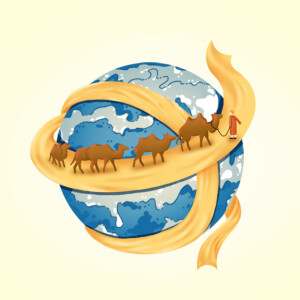Episodes

Monday Aug 14, 2023
Monday Aug 14, 2023
Chapter 1:What Was Cristiano Ronaldo About
"Cristiano Ronaldo" is a book written by Guillem Balague that provides an in-depth look into the life and career of the famous Portuguese footballer Cristiano Ronaldo. The book covers various aspects of Ronaldo's personal and professional journey, including his childhood in Madeira, his early years as a talented young player, his time at Sporting Lisbon and Manchester United, and his subsequent move to Real Madrid and later Juventus. It delves into Ronaldo's relentless work ethic, determination, and his drive to become one of the greatest footballers of all time. The book also explores his relationships with coaches, teammates, and family members, shedding light on the person behind the international superstar. Overall, "Cristiano Ronaldo" offers readers a comprehensive biography of this iconic sports figure.
Chapter 2:The Cristiano Ronaldo Filetype:pdf
"The Book Cristiano Ronaldo" is a fascinating exploration of the life and career of one of the greatest footballers in history. This meticulously researched and insightful book, available in PDF format, delves deep into the extraordinary journey of Cristiano Ronaldo, from his humble beginnings in Madeira, Portugal, to becoming a global icon.
The pages of this book unfold Ronaldo's early passion for the sport, his unwavering determination, and his relentless pursuit of excellence. It provides a comprehensive account of his rise through the ranks, showcasing his remarkable skills, unparalleled athleticism, and unrivaled goal-scoring ability. From his breakthrough at Sporting Lisbon to his stellar performances with Manchester United, Real Madrid, and Juventus, every chapter highlights the pivotal moments that shaped his legendary status.
Moreover, "The Book Cristiano Ronaldo" goes beyond his on-field achievements, exploring the man behind the player. It delves into his philanthropic endeavors, his unwavering work ethic, and his dedication to improving himself both physically and mentally. The book also sheds light on the challenges he encountered along the way and how he overcame them with resilience and sheer determination.
Filled with captivating anecdotes, exclusive interviews, and stunning photographs, this PDF book offers an intimate glimpse into the life of Cristiano Ronaldo. Whether you are a die-hard football fan or simply curious about the incredible journey of this sporting behemoth, "The Book Cristiano Ronaldo" provides a comprehensive and enjoyable read that celebrates the indomitable spirit of one of football's true icons.
Chapter 3:Cristiano Ronaldo Characters
Cristiano Ronaldo: The main character and protagonist of the book, Cristiano Ronaldo is a Portuguese professional footballer widely regarded as one of the greatest players of all time. The book explores his early life, rise to stardom, personal struggles, and remarkable achievements in the world of football.
Dolores Aveiro: Cristiano Ronaldo's mother, Dolores Aveiro, played a significant role in his upbringing. The book delves into her influence on his life and the strong bond they share. Her support and love for her son are portrayed throughout various stages of his career.
Sir Alex Ferguson: As the legendary manager of Manchester United, Sir Alex Ferguson played a pivotal role in Cristiano Ronaldo's career. The book highlights their relationship, the guidance provided by Ferguson, and the impact it had on Ronaldo's development as a player.
Lionel Messi: Although not a central character, Lionel Messi, Ronaldo's long-standing rival, is mentioned in the book. Their intense rivalry on the pitch and mutual respect off the field is explored, showcasing the constant battle for supremacy between two footballing giants.
Georgina Rodríguez: Georgina Rodríguez, Cristiano Ronaldo's partner, is another important character in the book. Their relationship and her support during various phases of his career are depicted, highlighting the role she plays in his personal life.
Fernando Santos: As the national team coach of Portugal, Fernando Santos guided Cristiano Ronaldo and his teammates to victory in the 2016 UEFA European Championship and the 2019 UEFA Nations League. His influence and tactical strategies are discussed in the book.
Florentino Pérez: Florentino Pérez is the president of Real Madrid, the club where Cristiano Ronaldo achieved great success. The book covers their relationship, Ronaldo's transfer to Real Madrid, and his impact on the club's history.
Jorge Mendes: Jorge Mendes, a prominent football agent, is depicted in the book as Cristiano Ronaldo's agent and a close confidant. The role he played in negotiating contracts, handling sponsorships, and managing Ronaldo's career is explored.
Teammates and Friends: Various teammates and friends such as Ryan Giggs, Wayne Rooney, Marcelo, and Nani are mentioned throughout the book. Their influence, camaraderie, and support for Ronaldo are showcased, emphasizing the importance of teamwork and friendship in his journey.

Thursday Aug 03, 2023
Thursday Aug 03, 2023
Chapter 1:Book written by Elon Musk
"Elon Musk: Tesla, SpaceX, and the Quest for a Fantastic Future" is a biography written by Ashlee Vance that provides an in-depth look into the life and achievements of Elon Musk. This book delves into the personal and professional journey of Elon Musk, showcasing his ambitious pursuits in revolutionizing the electric car industry with Tesla Motors, pushing boundaries in space exploration with SpaceX, and his involvement in various other ventures such as SolarCity and Neuralink. The author explores Musk's childhood, entrepreneurial spirit, work ethic, and determination, while also shedding light on the challenges he has faced along the way. It offers readers valuable insights into Musk's vision for the future and the innovative approaches he takes to make a positive impact on humanity.
Chapter 2:Why is the Elon Musk Best-selling
Innovation and Entrepreneurship: Elon Musk has been involved in numerous groundbreaking ventures, including Tesla (electric vehicles), SpaceX (private space exploration), SolarCity (solar energy solutions), and Neuralink (neurotechnology). His ability to envision and develop innovative technologies has captured the interest and admiration of many people.
Visionary Leadership: Musk's visionary leadership style sets him apart. He is known for pushing boundaries and challenging conventional thinking in various industries. His ambitious goals, such as colonizing Mars or transitioning the world to sustainable energy, have inspired millions of individuals worldwide.
Public Persona: Elon Musk is highly active on social media platforms, particularly Twitter, where he shares updates about his projects, engages with followers, and occasionally makes controversial or humorous statements. This direct and unfiltered communication style has attracted significant attention and media coverage, contributing to his popularity.
Media Coverage: Musk's ventures and ideas have received extensive media coverage over the years. Whether it is his successful rocket launches, the unveiling of new Tesla models, or his outspoken interviews, the media's focus on his activities has helped raise his profile and build a strong following.
Celebrity Status: Elon Musk's influence extends beyond his business achievements. He has become somewhat of a celebrity figure, appearing on talk shows and podcasts, participating in high-profile events, and having cameo appearances in popular TV shows. This exposure has further enhanced his public appeal and contributed to his best-selling status.
Chapter 3:Summary of the Elon Musk
"Elon Musk: Tesla, SpaceX, and the Quest for a Fantastic Future" is a biography written by Ashlee Vance that delves into the life and achievements of Elon Musk. The book offers a comprehensive overview of Musk's journey, from his childhood in South Africa to becoming one of the most influential entrepreneurs of our time.
The biography explores Musk's early ventures, including Zip2 and PayPal, highlighting his drive to revolutionize industries through innovation and disruption. It delves into the challenges he faced along the way, such as financial struggles and personal setbacks, as well as his relentless work ethic and determination to succeed.
Musk's vision for the future takes center stage in the book, with an emphasis on his involvement in SpaceX, Tesla Motors, SolarCity, and other groundbreaking ventures. Vance explores Musk's unwavering belief in sustainable energy and space exploration, showcasing his ambition to transform humanity and make significant contributions to society.
The author also delves into Musk's management style, which is characterized by his high expectations, demanding work environment, and relentless pursuit of excellence. The book paints a complex picture of Musk, capturing both his brilliance and his flaws, while shedding light on the immense pressure he faces as he strives to achieve his audacious goals.
In summary, "Elon Musk" provides a detailed account of the life and career of one of the world's most intriguing and influential figures. It highlights Musk's remarkable achievements, his unyielding determination, and his relentless pursuit of making a positive impact on the world through technological advancement.

Wednesday Jul 19, 2023
Wednesday Jul 19, 2023
Chapter 1:What is the When Breath Becomes Air about
"When Breath Becomes Air" is a memoir written by Dr. Paul Kalanithi. The book chronicles his life and career as a neurosurgeon, as well as his battle with stage IV lung cancer.
The memoir explores the themes of life, death, and meaning, as Dr. Kalanithi reflects on his experiences and contemplates the nature of human existence. He shares his journey from being a promising neurosurgeon to suddenly becoming a patient facing mortality.
Through his poignant and introspective writing, Dr. Kalanithi examines the intersections between medicine, literature, and philosophy. He explores questions about identity, the pursuit of knowledge, and the impact of illness on one's perception of self and purpose.
"When Breath Becomes Air" is a deeply moving book that captures the fragility and resilience of life, offering profound insights into what it means to confront mortality and find meaning in the face of a terminal diagnosis. It has resonated with readers worldwide, provoking thought and inspiring contemplation about the value of our time on Earth.
Chapter 2:Quotes of When Breath Becomes Air
"The future I had imagined, the one just about to be realized, the culmination of decades of striving, evaporated."
"You can't ever reach perfection, but you can believe in an asymptote toward which you are ceaselessly striving."
"Don't think I ever spent a minute of any day wondering why I did this work, or whether it was worth it."
"Human knowledge is never contained in one person. It grows from the relationships we create between each other and the world, and still it is never complete."
"What happened to Paul was tragic, but he was not a tragedy. I expected to feel only empty and heartbroken after you died. Instead, I found myself filled with love."
Chapter 3:How many chapters are in When Breath Becomes Air
The book does not have chapters in the traditional sense but is divided into two parts: "In Perfect Health I Begin" and "Cease Not till Death". Part one mainly focuses on Kalanithi's early life, his journey to becoming a doctor, and his diagnosis. Part two delves into his battle with cancer, his reflections on mortality, and his search for meaning in the face of death. Although the book lacks specific chapter divisions, it consists of various sections and sub-sections that guide the narrative.

Tuesday Jul 18, 2023
Tuesday Jul 18, 2023
Chapter 1:What is Can't Hurt Me book about
"Can't Hurt Me" is a book written by David Goggins, a retired Navy SEAL and former Air Force Tactical Air Controller. The book is part memoir and part self-help, focusing on Goggins' incredible life story and his philosophy of mental toughness.
In "Can't Hurt Me," Goggins shares his journey from an abusive childhood, obesity, and learning disabilities to becoming one of the most resilient individuals in the world. He discusses his experiences as a Navy SEAL, including rigorous training, combat deployments, and challenging missions.
The book delves into Goggins' mindset and how he overcame physical and mental obstacles through sheer determination. He introduces his concept of the "cookie jar," where he draws strength from past accomplishments during difficult times. Goggins also provides practical techniques for building mental resilience, pushing past one's limits, and embracing discomfort to achieve personal growth.
Throughout the book, Goggins emphasizes the importance of taking responsibility for one's life, embracing pain and suffering, and developing an indomitable willpower. He shares stories of his toughest challenges, including enduring extreme physical tests like ultra-marathons and SEAL Hell Week.
Chapter 2:Why is Can't Hurt Me a best-selling book
Inspirational Personal Story: The book chronicles the incredible life journey of David Goggins, who overcame significant adversity and transformed himself from an overweight, abused child to becoming one of the world's toughest endurance athletes. Goggins' story resonates with readers as it showcases the power of resilience, determination, and the ability to overcome seemingly insurmountable obstacles.
Motivational Lessons: Alongside his personal narrative, Goggins shares valuable lessons and strategies for self-improvement, mental toughness, and achieving peak performance. He provides actionable advice on mindset, goal setting, discipline, and pushing beyond perceived limits. Readers are inspired by his no-nonsense approach and find practical guidance to apply in their own lives.
Authenticity and Vulnerability: Goggins presents a raw and unfiltered account of his experiences, including his battles with physical and emotional pain, self-doubt, and insecurities. His willingness to share his vulnerabilities and failures resonates deeply with readers, making him relatable and human. This authenticity creates a strong connection between the author and the audience.
Unique Perspective: Goggins' background as a former Navy SEAL, ultra-endurance athlete, and record holder adds a unique perspective to his story. Readers are fascinated by his insights into elite military training, his participation in grueling races, and the extreme physical and mental challenges he has faced. This combination of experiences sets "Can't Hurt Me" apart from other motivational books.
Word-of-Mouth and Social Media Buzz: The book gained widespread popularity through word-of-mouth recommendations and social media exposure. Many readers found immense value in Goggins' teachings and shared their enthusiasm online, creating a viral buzz around the book. As more people heard about the transformative power of "Can't Hurt Me," its popularity grew, leading to increased sales and making it a bestseller.
Chapter 3: Can't Hurt Me plot
The book explores Goggins' journey from a troubled childhood filled with poverty, abuse, and prejudice to becoming one of the world's most exceptional individuals.
The plot of "Can't Hurt Me" revolves around Goggins' determination to overcome his limitations and push past his physical and mental boundaries. Through the book, he shares his personal experiences, challenges, and triumphs, offering valuable insights and lessons for readers.
The story begins by delving into Goggins' early life, highlighting the struggles he faced growing up in an abusive household. He describes how he had to overcome racism, illiteracy, and a lack of confidence to pursue his dreams. Goggins also opens up about an incident that led him to make a transformative decision: he witnessed the Navy SEALs during their hell week training on television and decided to join them, despite being overweight and out of shape.
The narrative then takes us through Goggins' grueling and intense journey to become a Navy SEAL. He recounts the relentless physical and mental challenges he faced during training, including enduring cold water exposure, sleep deprivation, and excruciating workouts. Goggins emphasizes the importance of embracing suffering, pushing oneself beyond limits, and developing an indomitable mindset to achieve success.
After completing his SEAL training, Goggins shares his experiences as a member of the elite special operations force. He describes dangerous combat situations and the emotional toll they took on him. However, it is during this time that Goggins discovers his passion for ultra-endurance events and sets numerous records in races like the Badwater 135 and the Ultraman World Championship.
Throughout the book, Goggins also provides the readers with practical tools and strategies to overcome obstacles, build mental resilience, and achieve personal growth. He emphasizes the power of accountability, self-discipline, and embracing discomfort as the keys to unlocking one's full potential.
"Can't Hurt Me" is not only a captivating memoir but also a motivational guide designed to inspire readers to confront their fears, shatter limitations, and strive for greatness. Goggins' story serves as a powerful reminder that with relentless effort, unwavering determination, and a refusal to be defined by circumstances, we can overcome any obstacle and achieve the impossible.

Monday Jul 17, 2023
Monday Jul 17, 2023
Chapter 1:What is Bad Blood book about
"Bad Blood: Secrets and Lies in a Silicon Valley Startup" is a non-fiction book written by journalist John Carreyrou. It narrates the rise and fall of Theranos, a biotech startup founded by Elizabeth Holmes. The book exposes the fraudulent practices and deceptive claims made by Holmes and her company.
Theranos promised to revolutionize the healthcare industry with their blood-testing technology, claiming to perform a wide range of tests using just a few drops of blood. However, Carreyrou uncovers the truth behind the company's operations and reveals that Theranos was unable to deliver on its promises.
Carreyrou investigates the intricate web of lies and unethical behavior within Theranos, including falsified test results, unreliable technology, and an environment of fear and intimidation for employees. He highlights the role played by Holmes, who presented herself as a visionary but ultimately perpetuated a massive fraud.
"Bad Blood" showcases the consequences of unchecked ambition and the dangers of blind trust in the world of startups and corporate culture. Through extensive research and interviews with former employees, Carreyrou provides a gripping account of the rise and fall of Theranos, shedding light on the ethical concerns surrounding the case.
Chapter 2:Why is Bad Blood a best-selling book
Intriguing Story: The book recounts the rise and fall of the blood-testing company Theranos, which was once valued at billions of dollars. It exposes the deception and fraud perpetrated by its founder Elizabeth Holmes, making for a captivating and shocking narrative.
Real-life Drama: The events described in "Bad Blood" are based on true events, which adds an element of reality and fascination to the story. Readers are often drawn to books that uncover scandalous or controversial topics from the business world.
Investigative Journalism: John Carreyrou, a Pulitzer Prize-winning journalist, thoroughly researched and investigated Theranos. His rigorous journalistic work is evident throughout the book, providing readers with an insight into the investigative process and how truth prevailed over deception.
Timeliness and Relevance: The rise and fall of Theranos received significant media attention, making it a widely recognizable story. By shedding light on the deceitful practices within a prominent Silicon Valley startup, "Bad Blood" taps into the public's curiosity about the inner workings of such companies and the consequences of their actions.
Ethical Implications: The story raises important questions about ethics, corporate culture, and the responsibility of individuals in positions of power. These themes resonate with readers and contribute to the book's popularity, as it prompts discussions about trust, accountability, and the potential dangers of unchecked ambition.
Critical Acclaim: "Bad Blood" has received widespread critical acclaim, with positive reviews praising its compelling storytelling and meticulous research. This positive reception further propelled its popularity and contributed to its status as a best-seller.
Chapter 3: Bad Blood plot
In a small, close-knit town called Cedarville, tensions run high as a long-standing feud between two prominent families threatens to tear the community apart. The story revolves around the Masons and the Carters, two wealthy families with a deep history of animosity towards each other.
The Mason family owns a successful manufacturing company that has dominated the town's economy for generations. They are known for their ruthlessness in business dealings and their control over local politics. On the other hand, the Carter family is renowned for their philanthropy and their commitment to social justice causes. Their influence extends beyond Cedarville, making them a formidable opponent for the Masons.
The conflict intensifies when Olivia Mason, the headstrong daughter of the Mason family, falls in love with Ethan Carter, the charismatic son of the rival clan. Their forbidden romance ignites a chain reaction of events that unravel the carefully woven fabric of society.
As Olivia and Ethan navigate their secret relationship, they become increasingly aware of the dark secrets their families hold. Corruption, deceit, and betrayal lurk beneath the surface, threatening to expose the true nature of both families.
Meanwhile, a series of suspicious incidents begin to occur, pointing to a sinister plot aimed at destroying one of the families. As the Masons and Carters find themselves on the brink of catastrophe, Olivia and Ethan take it upon themselves to unearth the truth and put an end to the cycle of hatred.
Throughout the story, alliances shift, revealing unexpected connections and hidden agendas. Friends turn into enemies, and enemies find common ground. Deep-rooted prejudices and grudges must be overcome as the characters confront their own demons and strive for redemption.
In the climactic finale, Olivia and Ethan uncover a shocking conspiracy that not only involves their families but also implicates several influential figures in the town. With the truth exposed, they must decide whether to uphold their family legacies or forge a new path towards forgiveness and reconciliation.

Friday Jul 14, 2023
Friday Jul 14, 2023
Chapter 1:What is Crucial Conversations book about
Crucial Conversations is a book that provides insights and strategies for effectively navigating difficult and high-stakes conversations. The book emphasizes the importance of approaching crucial conversations with clarity, openness, and respect in order to achieve meaningful and constructive outcomes. It delves into various aspects of communication, such as understanding the underlying dynamics of conversations, managing emotions, and fostering an atmosphere of safety and trust. The authors highlight the significance of dialogue rather than debate or silence when addressing sensitive topics and offer practical tools for achieving mutual understanding and finding common ground. Crucial Conversations serves as a guide, empowering individuals to handle tough conversations at work, home, or any other setting where important issues need to be addressed in a way that respects relationships while effectively resolving conflicts.
Chapter 2:Why is Crucial Conversations a best-selling book
Universal applicability: The book offers techniques that can be applied to almost any situation where important conversations need to take place. Whether it's resolving conflicts, giving feedback, discussing sensitive topics, or negotiating, the strategies provided in the book can be adapted to different scenarios.
Practical framework: The authors present a comprehensive framework for addressing crucial conversations, emphasizing the importance of creating a safe space, promoting mutual respect, and facilitating open dialogue. The book provides step-by-step guidance on how to prepare for and navigate these conversations successfully.
Real-life examples: The authors support their techniques with numerous real-life examples, which resonate with readers and help illustrate the concepts in practical terms. These relatable stories make the book engaging and facilitate a deeper understanding of the content.
Research-based approach: The book draws from extensive research in the fields of communication, psychology, and organizational behavior. By incorporating evidence-based practices, Crucial Conversations offers readers a well-founded approach to handling challenging conversations.
Accessibility: The book employs a clear and accessible writing style that makes it easy for readers to grasp the concepts and apply them in their own lives. The authors use straightforward language, avoiding overly technical jargon, making it suitable for a wide range of audiences.
Longevity and continued relevance: Since its initial release in 2002, Crucial Conversations has remained relevant due to its timeless insights and enduring principles. The book has been revised and updated over the years to ensure its continued usefulness in an ever-changing world.
Chapter 3: Crucial Conversations plot
The story begins with a few characters who find themselves in high-stakes situations where the outcome heavily depends on their ability to communicate and handle crucial conversations skillfully. The authors highlight that these conversations often involve differing opinions, strong emotions, and conflicting interests. They emphasize that how people handle such conversations is crucial for achieving desired results.
Throughout the book, the authors provide valuable insights into mastering these difficult conversations. They introduce crucial principles to guide readers through challenging dialogue, including creating a safe environment, focusing on facts, managing emotions, and exploring different viewpoints.
The authors also delve into the various communication styles people adopt during crucial conversations, such as silence or violence. They analyze the negative impacts of these ineffective approaches and offer alternative strategies to encourage honest and open dialogue.
Furthermore, the book outlines specific techniques for dealing with disagreements and misunderstandings constructively. It emphasizes the importance of active listening, asking open-ended questions, and establishing mutual purpose to foster understanding and resolution.
In addition to practical advice, "Crucial Conversations" incorporates real-life examples and case studies to illustrate how individuals have successfully applied the book's principles to transform their relationships and achieve positive outcomes.
Ultimately, "Crucial Conversations" serves as a comprehensive guide for improving communication skills, enabling readers to navigate challenging conversations confidently and effectively, fostering healthier relationships and achieving desired results in every aspect of life.

Thursday Jul 13, 2023
Thursday Jul 13, 2023
Chapter 1:What is The Silk Roads book about
"The Silk Roads: A New History of the World" is a book written by Peter Frankopan. It provides a comprehensive overview of the historical significance and impact of the Silk Road trade routes that connected Asia, Europe, and Africa. The book explores the interactions, exchanges, and cultural diffusion that took place along these ancient trade routes from prehistoric times to the present day.
Rather than focusing solely on the West-centric perspective commonly found in traditional histories, Frankopan's book emphasizes the central role played by the East in shaping the world's history. It delves into various themes such as geopolitics, economics, religion, culture, and warfare, highlighting how the Silk Roads were pivotal in shaping the political and economic landscape of the ancient and medieval world.
By examining the flow of goods, ideas, religions, and technologies across vast distances, "The Silk Roads" offers a broader perspective on global history and challenges conventional narratives. It takes readers on a journey through time, exploring the rise and fall of empires, the spread of religions like Buddhism, Islam, and Christianity, the exchange of scientific knowledge, and the emergence of new power centers along the Silk Roads.
Overall, "The Silk Roads" provides a fresh and nuanced understanding of world history, shedding light on the interconnectedness of civilizations and the enduring legacy of the ancient trade routes that shaped our modern world.
Chapter 2:Why is The Silk Roads a best-selling book
Unique Perspective: The book offers a fresh and alternative perspective on world history by focusing on the importance of the Silk Roads, which were a network of ancient trade routes connecting East Asia with the Middle East, Africa, and Europe. This unique approach provides readers with a different understanding of global events and their interconnectedness.
Comprehensive Scope: The book covers a vast period of time, spanning over 2,000 years, from the rise of empires in the classical era to the present day. It explores various aspects, including cultural exchanges, economic developments, and political shifts, providing readers with a comprehensive view of the historical significance of the Silk Roads.
Readable Style: Despite being a scholarly work, Peter Frankopan's writing style is accessible and engaging. He weaves together historical narratives, personal anecdotes, and vivid descriptions to make the book captivating and reader-friendly, appealing to both academic and general audiences.
Relevance: In an increasingly interconnected world, understanding the historical roots of globalization and the exchange of ideas, goods, and technologies becomes crucial. The Silk Roads resonates with contemporary debates on international relations, economics, and cultural interactions, making it relevant and thought-provoking.
Critical Acclaim: The book has received widespread critical acclaim from scholars, historians, and literary critics. Positive reviews, prestigious awards, and endorsements from renowned figures have helped generate attention, increasing its popularity among readers.
Chapter 3: The Silk Roads plot
Trade and Exchange: The primary purpose of the Silk Roads was to facilitate trade between different regions, allowing the exchange of goods, ideas, and cultural practices. Merchants traveled long distances, often braving harsh conditions, to transport silk, spices, precious metals, gems, and other valuable commodities. This trade contributed to economic growth, cultural diffusion, and the formation of diverse cosmopolitan societies.
Cultural Interactions: As merchants traversed the Silk Roads, they encountered and interacted with people from different cultures, religions, and civilizations. This led to the exchange of knowledge, beliefs, and artistic traditions. Religions such as Buddhism, Christianity, Islam, and Zoroastrianism spread along these routes, leaving a lasting impact on the religious and cultural landscape of Eurasia.
Technological Advancements: The Silk Roads facilitated the transfer of technological innovations across vast distances. Papermaking techniques, gunpowder, compasses, and silk production methods are some examples of the inventions and technologies that were transmitted along these routes. These advancements contributed to the progress of civilizations and significantly influenced future developments.
Political Dynamics: The Silk Roads not only influenced economic and cultural spheres but also played a role in political dynamics. Powerful empires sought control over strategic points along the routes to enhance their influence and access to resources. The rise and fall of various empires, such as the Roman Empire, Parthians, Kushans, Tang Dynasty, Mongols, and Ottomans, impacted the stability and security of the Silk Roads.
Decline and Legacy: The decline of the Silk Roads can be attributed to various factors, including changes in global trade patterns due to the emergence of maritime routes and political disruptions. However, the legacy of the Silk Roads remains significant. It fostered a sense of interconnectedness between civilizations and laid the foundation for future international trade networks. It also influenced the development of cultural syncretism and contributed to the rise of globalization in later centuries.

Wednesday Jul 12, 2023
Wednesday Jul 12, 2023
Chapter 1: Where Does Born a Crime Take Place
Born a Crime, written by Trevor Noah, takes place primarily in South Africa. The book provides a detailed account of Trevor Noah's childhood and adolescence in various neighborhoods of Johannesburg, the largest city in South Africa. It explores the complexities of growing up as a mixed-race child during the last years of apartheid and the tumultuous transition that followed. The story delves into the unique cultural and social dynamics of South Africa, which greatly influenced Trevor Noah's upbringing.
Chapter 2: The Thems Of a Book Born a Crime
The themes explored in the book "Born a Crime" by Trevor Noah are as follows:
Racial Identity and Apartheid: The book delves into Trevor Noah's experiences growing up as a mixed-race child in apartheid South Africa, where his existence was considered illegal under the regime's laws. The theme of racial identity is central to the narrative, as Noah navigates the challenges, prejudices, and complexities associated with being "born a crime."
Family and Belonging: Throughout the book, Noah explores the significance of family and how it shapes one's sense of belonging. He shares anecdotes about his mother, who played a pivotal role in his life, and other family members who supported him during difficult times. The theme underscores the importance of familial bonds and unconditional love.
Resilience and Survival: "Born a Crime" portrays Noah's resilience and ability to adapt to challenging circumstances. From his childhood encounters with violence, poverty, and racism to his struggles with identity, he demonstrates remarkable resilience in overcoming these obstacles and forging his own path.
Humor and Satire: As a comedian and television host, Noah infuses humor and satire throughout the book. His comedic perspective not only provides levity but also serves as a tool for analyzing societal issues, shedding light on the absurdities and injustices he experienced.
Education and Empowerment: Education plays a significant role in Noah's journey. Despite facing numerous barriers, he emphasizes the transformative power of education, highlighting its ability to provide knowledge, create opportunities, and empower individuals to challenge the status quo.
Love and Relationships: Noah reflects on various relationships in his life, exploring the dynamics between friends, romantic partners, and mentors. These stories underscore the importance of genuine connections, trust, and the impact they have on personal growth.
Prejudice and Racism: The book examines the pervasive nature of prejudice and racism within South African society. Noah's experiences illustrate the damaging effects of systemic discrimination, while also shedding light on his personal journey towards empathy and understanding.
Social Inequality and Poverty: "Born a Crime" also explores issues of social inequality and poverty. Noah shares vivid accounts of the disparities he witnessed growing up, highlighting the struggles faced by marginalized communities and the impact of socioeconomic factors on people's lives.
Chapter 3:How Many Chapters In The Born a Crime
"The Born a Crime" by Trevor Noah does not have traditional chapters. Instead, it consists of various short stories or anecdotes that make up the book. These stories are not numbered or divided into chapters. The book is organized thematically, exploring different aspects of Trevor Noah's life growing up in South Africa during apartheid and the challenges he faced as a mixed-race child.

Friday Jul 07, 2023
Friday Jul 07, 2023
Chapter 1:What's The Little Prince
The story revolves around a young prince who travels from planet to planet, encountering various characters and learning valuable life lessons along the way. The prince's journey serves as an allegory for the human experience and explores themes such as loneliness, friendship, love, and the pursuit of meaning in life.
Through its simple yet profound storytelling, "The Little Prince" delves into the nature of adulthood, society, and the loss of innocence. It encourages readers to reflect on their own lives, priorities, and relationships, reminding us of the importance of cherishing the simple things, fostering connections, and embracing imagination.
Although initially intended as a children's book, "The Little Prince" appeals to readers of all ages due to its universal messages and philosophical undertones. It continues to captivate readers worldwide with its timeless wisdom and whimsical charm.
Chapter 2:Who wrote The Little Prince
"The Little Prince" is a fictional book, originally written in French by Antoine de Saint-Exupéry. Published in 1943, it has become one of the most beloved and translated books in the world. The author himself, a pioneering aviator and writer, drew inspiration from his own experiences and imagination. Despite its seemingly simple narrative, "The Little Prince" delves into profound themes such as love, friendship, loneliness, and the importance of retaining childlike wonder. Through poetic language and whimsical illustrations, Saint-Exupéry crafted an enduring tale that continues to captivate readers of all ages.
Chapter 3:Books like The Little Prince
"Jonathan Livingston Seagull" by Richard Bach: This novella is a philosophical tale about a seagull who seeks to find meaning in life and break free from the constraints of the ordinary.
"Siddhartha" by Hermann Hesse: This novel follows the spiritual journey of Siddhartha, a young man seeking enlightenment and inner peace. It explores themes of self-discovery and the search for one's purpose in life.
"The Alchemist" by Paulo Coelho: This internationally acclaimed novel tells the story of a young shepherd named Santiago who embarks on a journey to fulfill his dreams and discover his personal legend. It delves into themes of destiny, following one's heart, and the importance of finding one's own path.
"The Prophet" by Kahlil Gibran: This collection of poetic essays offers profound insights into various aspects of life, such as love, friendship, joy, and sorrow. Each essay is like a fable, guiding readers through different aspects of human existence.
"The Secret Life of Bees" by Sue Monk Kidd: Although different in genre, this novel shares certain qualities with "The Little Prince." It explores themes of love, loss, and the importance of human connection through the eyes of Lily, a young girl searching for her place in the world.

Thursday Jul 06, 2023
Thursday Jul 06, 2023
Chapter 1:What's Why Nations Fail about
"Why Nations Fail: The Origins of Power, Prosperity, and Poverty" is a book written by Daron Acemoglu and James A. Robinson. It explores the factors that contribute to the success or failure of nations in terms of their economic development and political institutions.
The authors argue that inclusive institutions are crucial for a nation's long-term success, while extractive institutions lead to poverty and underdevelopment. Inclusive institutions provide a level playing field, protect property rights, encourage innovation, and allow citizens to participate in the decision-making process. On the other hand, extractive institutions concentrate power and wealth in the hands of a few, stifling economic growth and perpetuating inequalities.
The book examines the historical and contemporary examples to support its arguments. It looks at various countries and regions around the world, including both successful and failed states, to explain how different institutional structures shape the outcomes. The authors explore the role of politics, economics, culture, and geography in shaping institutions and their impact on nations' trajectories.
Chapter 2:Author of Why Nations Fail
The authors of "Why Nations Fail" are Daron Acemoglu, a Turkish economist, and James A. Robinson, a British political scientist. Published in 2012, the book explores the origins of economic and political success or failure of nations throughout history. Acemoglu and Robinson argue that inclusive institutions, which provide opportunities for broad-based participation and innovation, lead to prosperity, while extractive institutions, which concentrate power and resources in the hands of a few, result in poverty and stagnation. They analyze various case studies from civilizations around the world to support their thesis and shed light on the critical role institutions play in shaping nations' destinies.
Chapter 3:Similar Books like Why Nations Fail
"The Origins of Political Order" by Francis Fukuyama: This book explores the development of political institutions throughout history and their impact on society. Fukuyama examines how different cultures and societies have evolved politically, offering insights into why some nations succeed while others fail.
"The Wealth and Poverty of Nations" by David S. Landes: In this book, Landes explores the historical factors behind the rise and fall of nations, focusing on the role of institutions, culture, and geography. It offers a wide-ranging analysis of economic development from a global perspective.
"Guns, Germs, and Steel" by Jared Diamond: Diamond investigates the underlying reasons why certain societies developed more advanced technologies and became more prosperous than others. By examining geographical, environmental, and historical factors, he explores how these elements shaped the course of human history.
"Why the West Rules—for Now" by Ian Morris: This book takes a comparative approach to understand the differences in the development of Eastern and Western civilizations. Morris combines social development, geography, and biology to explain why the West has dominated global politics and economies over the past 500 years.
"The Bottom Billion" by Paul Collier: Focusing on the challenges faced by the world's poorest countries, Collier discusses the various factors that contribute to their persistent underdevelopment. He explores issues like civil war, corruption, natural resources, and governance, proposing practical solutions to address these problems.








